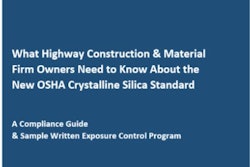The U.S Department of Labor will start enforcing its new concrete silica dust ruling for construction on September 23, 2017 (moved from June 23, 2017). With those new OSHA regulations coming up, it’s important to be up to date on all the new changes regarding the OSHA standards. But do facility owners and executives, and project managers know how to comply?
Joe Nasvik, a professional with more than 40 years of experience in the concrete and decorative concrete industries, collaborated with Bosch Power Tools to share his knowledge and insight on this issue, and the upcoming enforcement date. A member of the Decorative Concrete Hall of Fame, Nasvik served as a Bomanite contractor in the Chicago area for 20 years. He also worked in Las Vegas for several years constructing special features for casinos, including rock and waterfall features, architectural concrete, and swimming pool construction. He also served as the operations manager for a ‘start up’ precast company that held patents on concrete units used for wall construction.
Q: What is the new silica dust regulation and why is it happening?
Nasvik: When the U.S. Department of Labor issued its ruling aimed at better protecting workers from respirable silica dust, no one was surprised. Compliance with the new rule went into effect June 23, 2017, and enforcement begins September 23, 2017. The upgraded regulation substantially reduces the permissible exposure limits (PEL) for workers in the construction industry. The Department of Labor’s Occupational Safety and Health Administration (OSHA) will enforce a reduction in the amount of silica that workers can be exposed to over an eight-hour day from 250 micrograms per cubic meter of air to 50 micrograms.
Q: What exactly is silica? What kind is OSHA so concerned about?
Nasvik: Silicon (Si) is the second most common element on Earth, making up 28% of the planet’s crust. Oxygen is the most common element at 47% and aluminum is a distant third at 8%. Silicon combines with oxygen to form quartz (SiO2) — an example being sand. Silica is a component in a wide range of the Earth’s rock.
When the Dust Flies, All of Construction Pays the Cost
Q: Is respirable crystalline silica a threat to life?
Nasvik: Inhalation of respirable crystalline silica is a threat to life. Particles can be created by natural forces such as wind, which causes particles to collide and form smaller particles. According to OSHA, it’s estimated that 2.3 million U.S. workers are exposed to respirable silica dust at work each year.
Q: But aren’t there already OSHA regulations in place to limit silica exposure?
Nasvik: OSHA set limits on respirable crystalline silica dust exposure in 1971, shortly after the agency was created. These regulations, based on research from the 1960s and earlier, soon showed that they didn’t adequately protect workers. The limits were imposed as formulas that many people found difficult to understand. The new rule limits the amount of silica dust that workers can be exposed to on the job to 50 μg/m3 averaged over an eight-hour shift for all industries covered by the rule. That’s about 1/20th the size of a grain of salt.
Q: So what should contractors and people on the jobsite do to avoid silica dust exposure?
Nasvik: Employers are required to use “engineering controls” such as vacuum dust collection systems and water-delivery systems to limit worker exposure to respirable silica dust and use respirators as required. Specified exposure control methods are referenced in OSHA Table 1.


















